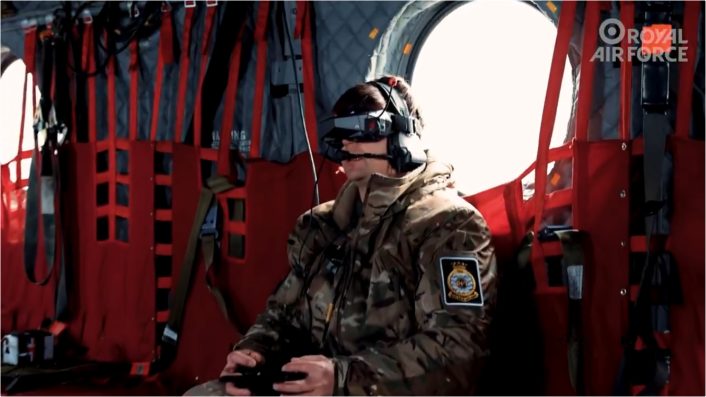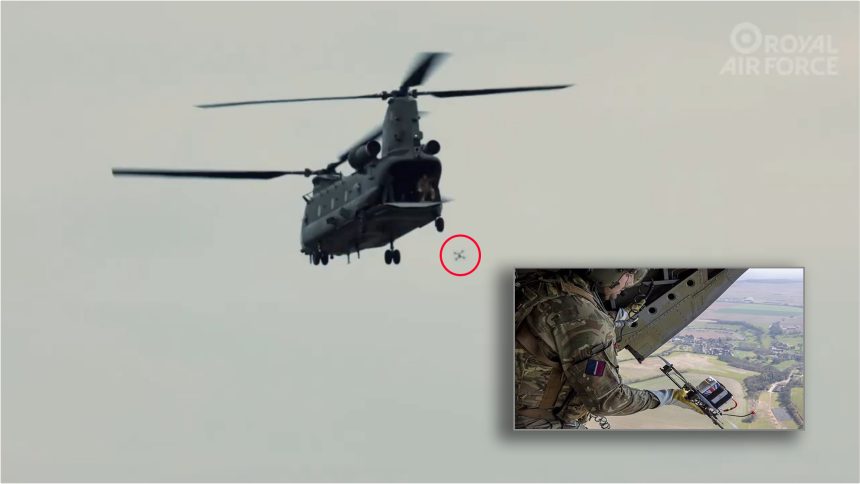The RAF said that FPV drones have proven their ‘effectiveness in recent conflicts’, reflecting the service’s vision of a future land war in Europe.
In an exercise marking the increasing tactical importance of First-Person View (FPV) drones, the Royal Air Force (RAF) announced on May 10, 2025 the completion of a trial deployment of one such UAV from a CH-47 Chinook helicopter, in a trial called “Hornet’s Nest.” The service said in a post on X that the “UK Defence is investing in agile tech to stay ahead. First Person View (FPV) drones can jam targets, scout terrain, and strike targets – all in one flight.”
The post did not mention when and where the trial took place, only mentioning this happened recently. The accompanying short 19-second video showed personnel wearing FPV visors to control the small quadcopter UAV as another crew member released it from the rear ramp. The clip shows the FPV operations both from inside and outside the Chinook, with one shot also showing footage from the drone’s camera beamed onto an external console.
The effort is similar to the one of the French Army’s (Armée de Terre) 3rd Combat Helicopter Regiment (RHC), which conducted an experiment in Dec. 2024 integrating FPV attack drones with SA341 Gazelle light attack helicopters.
UK Defence is investing in agile tech to stay ahead. First Person View (FPV) drones can jam targets, scout terrain, and strike targets — all in one flight.
A trial deploying FPVs from an RAF Chinook helicopter called Hornets Nest was recently completed. pic.twitter.com/3CyI7kN5PD
— Royal Air Force (@RoyalAirForce) May 9, 2025
Tactical need
The FPV drone’s payload bears the U.K. flag, the Union Jack, and is similar in design to the several off-the-shelf commercial UAVs that were initially fielded by the Russian and the Ukrainian armies by late-2022, used to strike each other’s land targets. The aircraft were merely strapped with explosives and flown into bunkers, trenches, fortified positions and infantry.
Purpose-built kamikaze FPV drones, sharing largely the same design, subsequently appeared with a different set of specialized electronics, visors, consoles, cameras and some anti-jamming functions. It is not clear if the drone seen in Hornet’s Nest is a commercial drone strapped with a payload replicating an explosive, or a dedicated purpose-built military drone.
The second option could be likely as the RAF said it wants to “jam targets, scout terrain, and strike targets,” although it is unclear if all those capabilities have been tested in the Hornet’s Test trial. The specifications of the UAVs are unknown, however it does appear that drones of two different sizes were used.
The RAF said in a statement quoted by Janes: “UK defence is embracing FPV drones due to their proven effectiveness in recent conflicts, the tactical advantages they offer on the battlefield, their alignment with future military strategies, and the ability to rapidly train personnel in their use.” FPV drones offering thermal imaging provide “a significant advantage in night-time operations, reducing the risks associated with crewed missions in low-visibility conditions,” helping maintain “a modern and adaptable fighting force.”

The FPV drones can also scout ahead of troop insertions for tactical surveillance, and, while carrying explosives, can also strike targets they identify during the aerial reconnaissance – if the need arises. This increases the helicopter’s field of view, with the onboard Electro-Optical (EO) turret looking at one area, and the drone surveilling another.
Networking with ground troops and possibly even the RAF’s MQ-9B Protector RG1 drone and AH-64E Apache attack helicopter – itself capable of controlling UAVs – will allow flexibility in engaging many ground targets.
Challenges
While it introduces a new capability to leverage emergent technologies, a Chinook carrying a single FPV drone would be insufficient, and the RAF can be expected to conduct several such tests to refine tactics and procedures to operate many of them from inside a single aircraft. The service would also decide whether a single operator or more would be present inside the helicopter to operate the UAV.

The RAF would also be expected to check the possibility of the drone being affected by the rotor wash or colliding with the Chinook’s airframe. We can expect a degree of autonomous capability for a UAV design that the service would finally procure, to ease its in-flight handling, launch and recovery.
Overall, the capability is handy when releasing troops and cargo in air defended battle spaces where the FPV drones swarms can overwhelm anti-air batteries and/or jam radars and enemy communications. This reflects the RAF’s vision of what a land war between NATO and Russia in Europe would look like.
RAF Chinooks
The RAF’s current operational Chinook fleet includes Mk 5, Mk 6 and Mk 6A variants, all equipped with a common digital glass cockpit. These are based at JHC FS Aldergrove, RAF Odiham, RAF Benson, operated by the 18 Squadron, 27 Squadron, 28 Squadron and 7 Squadron.

The Chinook HC Mk 6 was acquired as a UK-specific variant of the CH-47F and also introduced a Digital Automatic Flight Control System (DAFCS, pronounced ‘daffics’), greatly enhancing handling and safety, particularly when operating in recirculating dust or snow conditions. The Chinook HC Mk 5 is an upgraded version of the extended-range Mk 3, or ‘fat tank’ aircraft, which carries double the fuel load of a standard Chinook.









